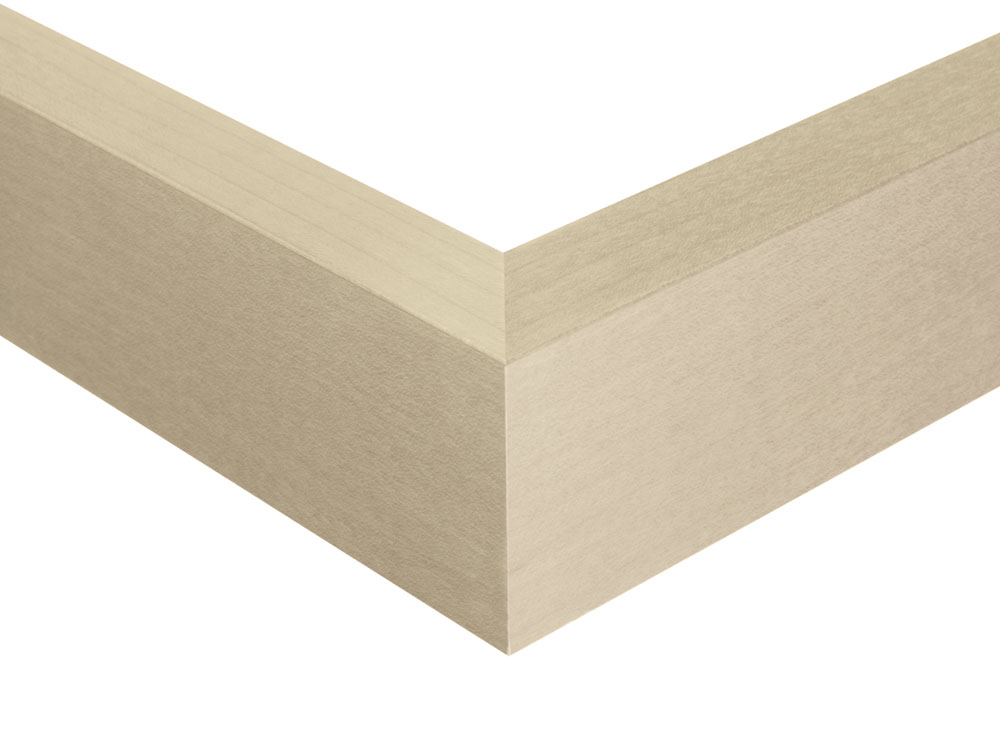THE WAY OF PERFECT PROTECTION
Preservation guidelines for framing
On the occasion of his invitation to the exhibition "In Detail. The World of Conservation and Restoration," we spoke with Alexander Fohs - a state-certified restorer for library and archive materials and responsible for graphic conservation at the Tyrolean Provincial Museums - on the topic of conservation framing. Many of his current restoration cases show damage due to improper archiving or framing. For centuries ago, no one thought that works would one day end up in museums or become important contemporary witnesses. Even we don't know what will happen to our pictures one day. Will the artist, who is still unknown today, become a star someday, will the photo print become a unique specimen because the image file has been lost, or will this one drawing be the only memory of a loved one.
Anyone who owns a picture wants to preserve it, to maintain its condition and thus its value. But no one can enjoy them if they slumber in dark archives. If a few basic points are observed, pictures can be displayed with a clear conscience and preserved for the future. However, the more sensitive or valuable the image, the higher the level of protection should be.
The spectrum ranges from images that can be reproduced by the user himself, such as his own photo prints, to expensive editions or unique copies, to centuries-old documents, certificates and works. Even in the case of own prints, avoidable damage should be avoided - if only for reasons of sustainability. In the case of unique works, the necessity is self-evident.
Like everything else, paper and colour of pictures are subject to an aging process. Light, acids, adhesives and humidity can accelerate this and cause irreparable damage. Therefore, a good framing must keep out harmful environmental factors and must not cause any damage itself. Not every picture frame meets these requirements and even MDF backs do not meet the minimum requirements. Therefore, all HALBE magnetic frames are equipped with PAT-tested hard foam board or age-resistant backing made of Klug corrugated cardboard and thus offer the best basis for conservation framing.
Because it pays to observe the basics of conservation framing to avoid costly - if at all possible - restoration later. We show you the five basics below.
More detailed tips for mounting the pictures in the picture frame can be found in our know-how area mounting.
Light can cause serious damage. Especially invisible UV radiation - but also radiation outside the UV spectrum. While newsprint browns within days under daylight, modern papers and colours are much less sensitive. However, long color fastness does not mean that there is no damage to the image, it just takes longer. Especially in areas exposed to daylight and opposite windows, UV protection contributes to long-term color fastness.
While normal glasses filter only 40-50% of UV light, our Plexiglas, Optium Museum Acrylic and Artglass Protect protect over 99% from harmful UV radiation. Artglass UV72 and UV92, as their names suggest, provide 70 and 92% protection from UV radiation, respectively.
Nevertheless, avoid direct sunlight. In the case of very sensitive works, it may also be necessary to limit the amount of light by restricting the duration of the exhibition.
In the Tyrolean provincial museums, for example, the maximum permissible light energy is limited to 50 lux for an exhibition duration of three months. Or the lighting in museums is only switched on when the visitor approaches the display case or pictures.

For sensitive surfaces such as paintings, sketches, pastels, watercolors or collages, a distance to the glass is mandatory. For photos or prints, a distance prevents colour from peeling off or damage. A 1.5 mm passepartout is the easiest way to create distance. If the paint application is thicker, it must be 3 mm. The largest distance, 5 to 20 mm, can be achieved with insert frames or spacer frames. In the case of a stock of interchangeable frames, a high insertion depth is recommended, which can be filled with cardboard boxes if necessary, in order to remain flexible in the future.

How wide a passepartout should be is ultimately a matter of taste. It usually looks harmonious when the width of the passepartout edge is about 10-12% of the size of the longer side. Small pictures can be optically enlarged by large passepartout frames, so that they do not get lost on the wall. The colour of the passepartout should be a shade darker or more yellow than the paper of the picture. So the picture looks more white, more fresh and new.

It is best to try it out for yourself and design your passepartout in our configurator. You can also use the picture upload function to see directly how your motif appears framed.
In framing, design and craftsmanship must interact to enhance the character of the image and ensure long-term preservation. The requirements for protection and mounting of the paper must be met. For example, the object should not be damaged by the frame or the materials inside.
Typical materials that have direct contact with the picture are mounts, background cardboard and the frame back. Here it is necessary to pay attention to aging resistance of paper materials, which are manufactured according to the technological basis of the international standard DIN ISO 9706, for this purpose five manufacturing criteria must be met:
- The pulp used is 100% bleached cellulose free of recycled or lignified fibers. (Kappa number 1 - 2)
- The materials are neutral/synthetic (no alum added) sized.
- The material is free from acid-forming components.
- The buffer with natural calcium carbonate (GCC) against environmental acids is greater than 2%.
- The pH value is between 8.0 and 9.5 (according to DIN ISO 6588-1: 2012 cold extraction).
When framing and archiving photographs, attention should be paid to a successfully passed Photographic Activity Test (PAT) ISO 18916:2007.
All HALBE-frames used paper materials are from KLUG-CONSERVATION and without exception meet the highest museum requirements. They are certified according to DIN 6738, ISO 16245, ISO 9706 and ANSI Z 39.48-1992 and have passed the PAT according to ISO 18916:2007. You receive a legally binding quality guarantee for all KLUG materials.
The CLASSIC and DISTANCE magnetic frame have a back panel made of PAT-tested hard foam board. The DISTANCE also comes with an aging-resistant back panel. CONSERVO, CONSERVO-DISTANCE and PROTEC are equipped exclusively with aging-resistant paper materials.
Tip
If several images are to be shown in one frame size and the sheet formats differ, this can be compensated by passepartouts. With only small differences (a few mm to 1 cm), the same passepartout cutout is adapted to the smallest format and the larger image is further covered. For medium differences (up to 10 cm), different edge widths are used. Larger differences speak for different frame sizes, then the wall design is of special importance.

A heavily damaged graphic. On the one hand, the paper is browned by light over a wide area. Except for two light streaks on the left and top here, the frame rail has cast a shadow. The dark spots around the motif are probably acid damage caused by an unsuitable wooden board backing. Moisture damage cannot be ruled out either.
Even if the picture frame is mainly to be adjusted to its motif, the place where it will hang later - as far as this is already certain - should be taken into account in order to help in the search for the suitable picture frame. There are two approaches. On the one hand you can orientate yourself on the material mix of the room and on the other hand you can set accents. A picture frame in natural walnut can set great accents in a white room. Each additional picture frame must be natural walnut.
When accents are set, they must be unambiguous and conspicuous. For example the combinations wood - aluminium / black - white or colour - natural tone. Different, but similar materials, for example an oak natural frame to beech natural furniture can "bite" and look like an accidentally wrong choice.

Residue from old bonding that has penetrated to the front.
Unfavorable ambient conditions can also cause damage. These can be caused by fluctuating humidity or also evaporation from fresh wall paint or adhesives from furniture or carpets. Particular care must be taken to ensure stable relative humidity, especially in the case of highly sensitive papers or when transporting them on museum loan. A simpler option than active air conditioning is the Protect magnetic frame. This minimizes fluctuations in relative humidity over a certain period of time in its sealed interior by means of passive buffer materials. However, it requires continuous control. Good rear ventilation of the frames, which is provided by the distance between the wall and the frame in all HALBE frames and can be further increased in the CONSERVO by turning out the spacers, helps to prevent harmful gases from entering the frame. In extreme cases, the distance also protects against water penetration.

Aluminium frame
Aluminium as a technical material looks simple, smooth, angular, filigree and therefore rather noble and cool. Straight-line or technical images are particularly impressive in a harmonious aluminium frame. Aluminium frames go well with modern works and set cooler colours particularly beautifully in scene.
Our aluminium colours are very neutral and match many motifs. It is therefore a safe choice. Especially with frequent changes and varied motifs, aluminium brings a calming stringency due to its simple restraint.
Especially where a lot of metal is used in the environment, for example in offices, public buildings or for certificates, aluminium frames are the ideal choice. If fire protection is important, non-combustible aluminium is the only option.
Aluminium frames are timeless, stable and very long-lasting. The frame remains true to colour for a long time and hardly changes over the years. Anyone who regularly expands and mixes their inventory is well advised to use aluminium.

Wooden frames
As a natural material with its own character, wood has a warm appearance and soft edges make it smooth and natural. Wood frames with a visible grain are also often perceived as more valuable. With the right choice, the wood with its strong character emphasises the effect of the picture particularly well.
Nature shots or pictures in natural colours unfold their effect better in wooden frames. You should also match the material to your furniture. If, for example, the picture is hung in an environment with lots of real wood furniture or wooden floors, this theme can be taken up. Then the types of wood should match, or you should ideally choose the same type of wood. If you would like to set accents by a change of style, it is better to use a different colour or aluminium than to combine different types of wood.
Wooden strips bring liveliness with them. Slight variations in grain and colour are normal and desirable. Anyone who wants to achieve absolute uniformity chooses aluminium.
You should pay attention to the following with wooden strips
Wooden frames as well as wooden furniture or wooden floors change over time due to light. If you hang a new wooden frame next to an old frame, you will notice differences. Our woods also grow in the forest and vary in colour and grain. We therefore sort our mouldings so that a frame always consists of four matching pieces. Wooden frames are therefore more expensive than aluminium frames. So if the budget is your priority, aluminium frames are the cheaper choice.

If you take these five tips to heart, you have done a lot to preserve the value of your paintings. For real treasures, you can find local experts via the Association of Restorers www.restauratoren.de. This article was supported by Alexander Fohs - Tiroler Landesmuseum and Michael Kühner - KLUG CONSERVATION.
Support for this article was provided by Alexander Fohs - Tiroler Landesmuseum and Michael Kühner - KLUG CONSERVATION.

These colours are available in our shop:
Aluminium profiles
Silver matt
White matt
Black matt
Medium grey matt
Brushed stainless steel
Chrome glossy
Palladium matt glossy
Oak natural
Oak black
Maple natural
Maple white
Alder dark
Alder brown
Walnut natural
Wooden profiles
On our profile and colour overview you will find a detailed list of all available colours.
You can also choose the right colour from sample sets.
A bright and filigree motif also needs a bright frame that does not distract from it or knock it out. The darker the frame, the harder the border to the wall. This can be used with caution to focus strongly on the image as long as the frame itself does not become the focus of attention.
A dark and vibrant subject, on the other hand, requires a dark frame, but can also tolerate a much wider color spectrum than a bright motif. For example, a bright frame around a dark subject can create the perfect soft contrast on a dark wall.

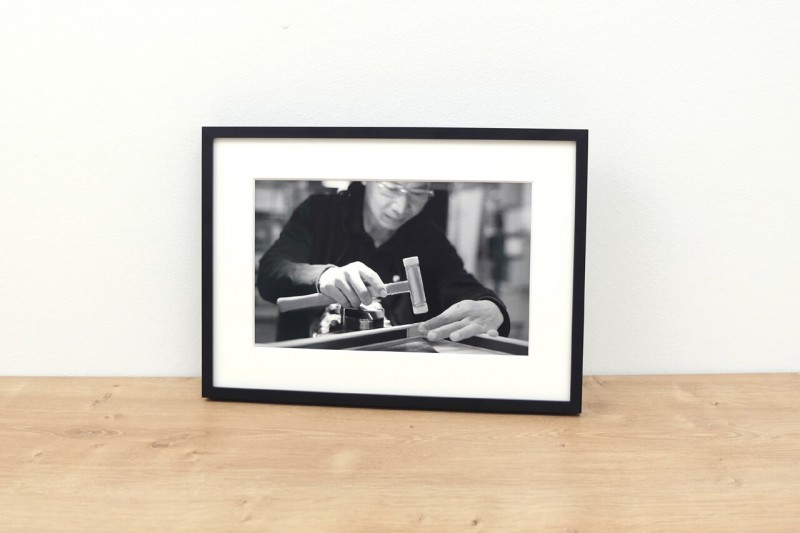
Here you can see browning damage of unknown cause as well as an inscription on the back penetrated on the front with a copying pen - a damage that can hardly be repaired. This would not have happened with a soft pencil.
Dark motif framed in light and dark HALBE frame
The structure and colour of the paper are also important in determining the right frame.
Smooth and bright white papers also look good in finely structured aluminium. Especially when a white frame is desired, the bright white aluminium frame is best suited.
Structured, cream-coloured to wavy papers look great in lively structured wood. Here the slightly cream-coloured maple white is suitable. The structure of the paper is reflected in the wood and the broken colours let the yellowish paper shine.

The colors of the motif determine the possible colors of the picture frame, because the colors must harmonize with each other. The frame has a particularly beautiful effect when a dominant colour from a drawing or print is picked up again. This can also be the white of the paper. Black picture frames are an excellent choice for black and white pictures, but white frames also look very stylish here, depending on which colour shade predominates.


Black frame picks up black motif; silver frame picks up light grey motif
There are two approaches for the color selection of the distance strips. On the one hand you "extend" the frame inwards, i.e. you adapt the spacers to the frame colour. Or you "pull up" the cardboard to the outside, i.e. you choose spacer strips to match the cardboard colour. For example: a black frame is combined with black strips or a white background cardboard is combined with white strips.
Tip
If in doubt, choose distance strips in the color of the background cardboard, especially if there is no color matching the frame.

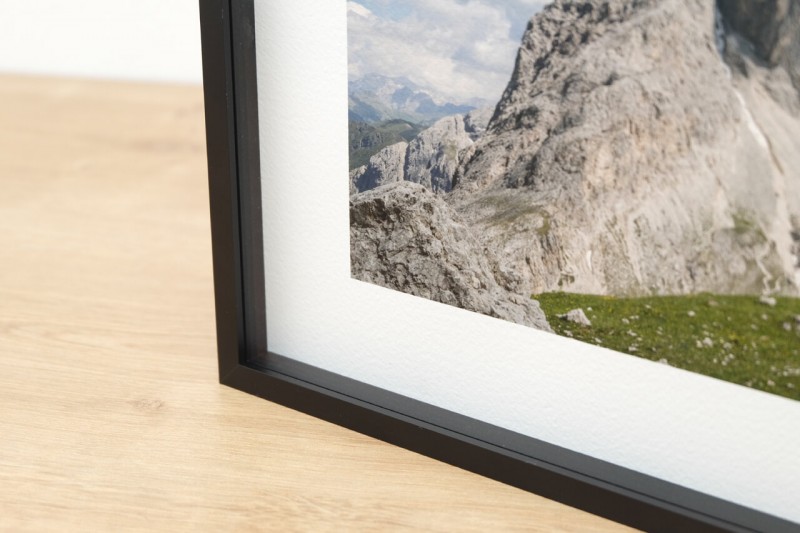
Distance strips in white, suitable for background cardboard and distance strips in black, suitable for frame
If you are still hesitant about your choice of colour, want to use the frame for changing motifs or want to create a neutral, uniform line, choose aluminium in matt silver. Plain silver is almost always suitable because it reflects the surrounding colours and adapts ideally to all motifs.
Colourful picture frames such as blue, green, yellow or turquoise are a creative no-go. Only with great sensitivity, perfectly matched to the series of motifs and presented in large neutral exhibition rooms do colored frames unfold their special effect.
Our profiles and strips differ primarily in width. The basic rule is: small size = small profile, large size = wide profile to maintain proportions. If you have several pictures in very different sizes, which belong together, you can either go to a medium width or combine different widths, as long as shape, material and colour remain the same.
Rounded profiles such as Alu6 and Alu12 appear softer and optically thinner. The narrow and flat Alu6 looks even more filigree due to the fine radii and the picture frame is thus particularly restrained. It is a good choice especially for small formats.
The shapes of the surroundings can also be picked up. Round shapes in furniture and in the room can be reflected in a rounded profile. Angular shapes are more in favour of angular profiles.
For frames over 1200x1400mm to 2000x3000mm, only wide profiles and strips are available for stability reasons. The deep versions in Alu18 or Holz22 are particularly suitable here. Due to the additional depth, the frame also appears plastic in large formats and provides additional stability.

The various profiles and strips can be found in our profile and colour overview in cross-section and with dimensions.
Glass also plays an important role for the picture, because it separates the picture from its surroundings and the viewer. The tasks of the picture glass are manifold and range from protection against dust and contact to UV protection. At the same time, it ideally provides an unclouded view of the picture. The aim is that the glass is best invisible when observing the picture.
Pay particular attention to the right choice of glass when the frames hang directly opposite windows. Here the finely frosted white glass often achieves the best effect.
You will find detailed information on the correct choice of picture frame glass in our knowledge section on picture glass.
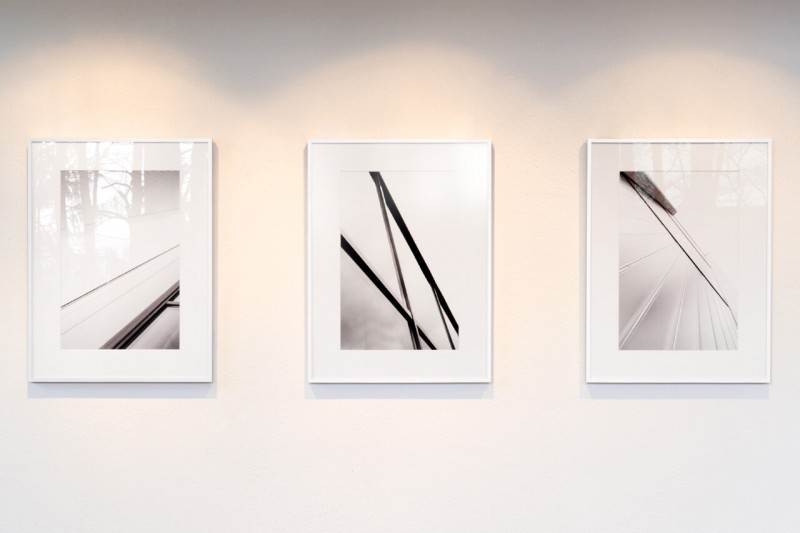
The decision on the insertion depth is less a design decision than a purely technical one. The frame must be adapted to the image on its substrate and, if necessary, to the thickness of the passepartout. The insertion depth is calculated as follows:
Image thickness + passepartout thickness = insertion depth
For instance:
1.5 mm + 3.0 mm = 4.5 mm
Standard:
0-2mm. Suitable for thin to very thick paper or common paper (e.g. 300g/m²) with 1.5mm passepartout.


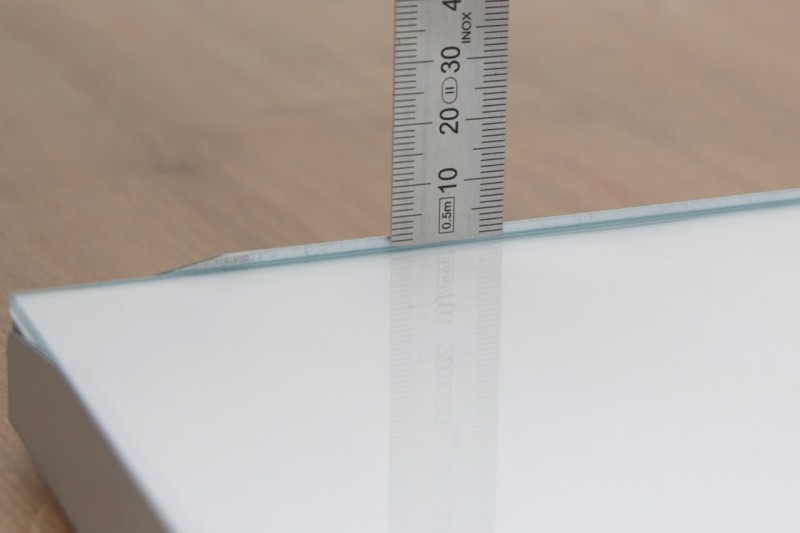
Image thickness: 0,5mm + passepartout thickness: 1,5mm = insertion depth: 0-2mm
With insertion depth:
If the inserted material is thicker than 2mm, the frame must be adjusted to the total thickness. For example for Dibonds, framing with 3mm passepartout or in folding passepartout, as well as working on a carrier cardboard. An individual insertion depth allows a tolerance of up to 25 mm.



Image thickness: 1,5mm + passepartout thickness: 3mm = insertion depth: 4,5mm
If you work through all these points bit after bit and reflect, at the end of the way there is the perfect frame for you, with which you will have a guaranteed pleasure for a long time!
Share your framing: #halbeframe
Browning due to light. You can see the lesser discoloration behind the dark areas on the back.
Trickle through burst pipe in the Ferdinandeum, Dutch Collection 2021
Image credits:
Image section 2.1.: Left: Paulus Pontius (1603-1658), after Peter Paul Rubens (1577-1640), Ferdinand on Horseback, Recto, DG NL 91, copperplate engraving, TLM Grafische Sammlung, © Tiroler Landesmuseen, Alexander Fohs
Right: Verso, DG NL 91, © Tiroler Landesmuseen, Alexander Fohs
Image section 2.2.: Left: Jan Georg van Vliet, The Arts and Crafts (Sheet 15), Recto, DG NL 78/15, 1635, etching, TLM Graphic Collection, © Tiroler Landesmuseen, Alexander Fohs
Right: Verso, DG NL 78/15, © Tiroler Landesmuseen, Alexander Fohs
Image section 2.3.: © KLUG-CONSERVATION
Image section 2.4.: Left: Verso, NL 16, © Tiroler Landesmuseen, Alexander Fohs
Right: Marie Catherine Prestel after Allert van Everding, Norwegian River Landscape (detail), recto, NL 16, 1783, pen and ink in gray-brown/graphite on paper, TLM Graphic Collection, © Tiroler Landesmuseen, Alexander Fohs
Image section 2.5.: © Tiroler Landesmuseen, Laura Resenberg, © Tyrolean Provincial Museums, Günter Richard Wett
Tip
With the right design of the picture frame you put your picture in focus. Read here how to do it:
https://www.halbe-rahmen.de/en/know-how/designing-picture-frames/
Tip
Present your artwork perfectly in the frame. From passepartout to free mounting. We show you how it's done:
Tip
For the protection of works on paper, the German Museums Association has published a list of recommended actions. We summarize the most important points here:
https://www.halbe-rahmen.de/magazin/en/protection-of-paperwork-in-times-of-rising-energy-prices/
No matter how well the framing is done and the environmental conditions are, sensitive works may only be displayed for a limited time. Here, our magnetic frames allow for quick and gentle framing and unframing, ideally together with background cardboard and, if necessary, passepartout.
The basic rule is that the picture is the focus of all considerations. If you want to present it in the long term, you should frame it. A picture frame fulfills many different tasks. It not only supports the visual effect of the picture, but also serves its development. Thus, a suitable picture frame can also be called the perfect stage for the picture. The picture and frame merge into a single unit and a symbiotic relationship is created.
Another function is protection. The frame allows a picture to be hung without damage. It protects against mechanical damage such as bends, tears, bumps, fingerprints, dust, dirt or vandalism. Equipped with the right picture lock, it can also protect against accidental or unauthorized access. Thus, a frame not only protects the picture, but is incidentally a significant increase in value.













